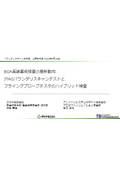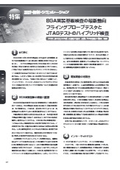This is a flagship model that arranges probe heads on both the top and bottom, enabling simultaneous in-circuit testing of the front and back of the substrate.
Four probes are arranged on the top side of the substrate and two on the bottom side. Each probe can move freely and at high speed, achieving an astonishing inspection speed that is world-class in its category. By using the flying probes on both the top and bottom simultaneously, a combination inspection with up to six probes allows for simultaneous contact inspection at both points on the top and bottom sides of the substrate. This significantly expands the inspection range and further accelerates inspection time. It is equipped with a wealth of features and boasts world-class standards in speed and positioning accuracy. ★ You can bring your substrate to our demo room at our Okayama headquarters for evaluation testing ★ We can conduct a series of tests including the creation of inspection programs, inspections using actual substrates, and summarizing evaluation results. If you are interested, please apply through the 'Contact Us' section below.
Inquire About This Product
Related Videos
basic information
To ensure that electronic devices function correctly, the electronic circuit board within the device must operate normally. The electronic circuit board becomes operational when electronic components are correctly mounted on the printed circuit board (PCB) and power is supplied. The process of contacting a dedicated probe to the electronic circuit board, which has electronic components mounted, and applying minute electrical signals for testing is called In-Circuit Testing (ICT), and the device used for this testing is referred to as an In-Circuit Tester. This method allows for the inspection of "connection reliability between electronic components and the board," "the values of individual mounted electronic components (such as resistors and capacitors)," and "diode polarity," without imposing unnecessary loads on the board itself. It is also known as MDA (Manufacturing Defect Analyzer). Main inspection items include: - Solder shorts and opens - Pattern disconnections - Missing components - Incorrect component values - Reverse insertion of polarized components - Lifted leads of ICs and connectors - Operation confirmation of digital transistors, optocouplers, and Zener diodes - Other simple function tests.
Price range
Delivery Time
Applications/Examples of results
【Adopted Industries】 EMS, EMDS companies Semiconductor manufacturing equipment Communication infrastructure and servers Automotive, aircraft, and marine Medical devices Industrial machinery and robots FA machine tools Power generation and power systems 【Use Cases】 ■ Inspection of mass-produced items Connected to loaders/unloaders for automated/unmanned inspection even in large lots ■ Inspection of multi-variety small quantity substrates No need for dedicated jig manufacturing costs; easy identification of defective areas ■ Inspection of prototype substrates Function tests responsive to design changes (applying voltage to the substrate to confirm circuit operation (ON/OFF) and measure direct current) ■ Implementation confirmation inspection during model switching Verification of the mounting program for the first lot and checking for set errors during model switching ■ Defect analysis inspection Inspection of substrates that failed functional tests and defect analysis of substrates that failed in the market We have a proven track record of being utilized in various other applications as well. For more details, please contact your sales representative.
Detailed information
-

APT-1600FD
Line up(4)
| Model number | overview |
|---|---|
| APT-1600FD | Dual-side inspection compatible machine |
| APT-1600FD-A | Dual-side inspection compatible, inline machine (model with automatic transport conveyor) |
| APT-1600FD-SL | Dual-side inspection, large board compatible machine |
| APT-1600FD-SL-A | Dual-side inspection, large board compatible, inline machine |
catalog(16)
Download All Catalogs![Accelerating Inspection of Flying Probe Testers Using Deep Reinforcement Learning [Ehime University Collaborative Research Material]](https://image.mono.ipros.com/public/catalog/image/01/b78/706831/IPROS8285943113191609983.jpeg?w=120&h=170)

![Accelerating Inspection of Flying Probe Testers Using Deep Reinforcement Learning [Joint Research Material with Ehime University]](https://image.mono.ipros.com/public/catalog/image/01/844/760295/IPROS14771536501121226558.jpeg?w=120&h=170)

News about this product(30)
Company information
Founded in 1894 as a textile company, Takaya Textile expanded and established its electronics division in 1966, beginning the assembly of transistor radios. Currently, in addition to contract manufacturing services (EMS) related to electronic devices, the company actively manufactures and sells in-circuit testers (printed circuit board inspection devices), RFID-related equipment (technology that enables information exchange through short-range wireless communication from IC information tags), and engages in IT consulting and system solutions, among various electronics businesses both domestically and internationally. We will continue to evolve as a corporate group that contributes to the development of society, with textiles and electronics as our two pillars.


















